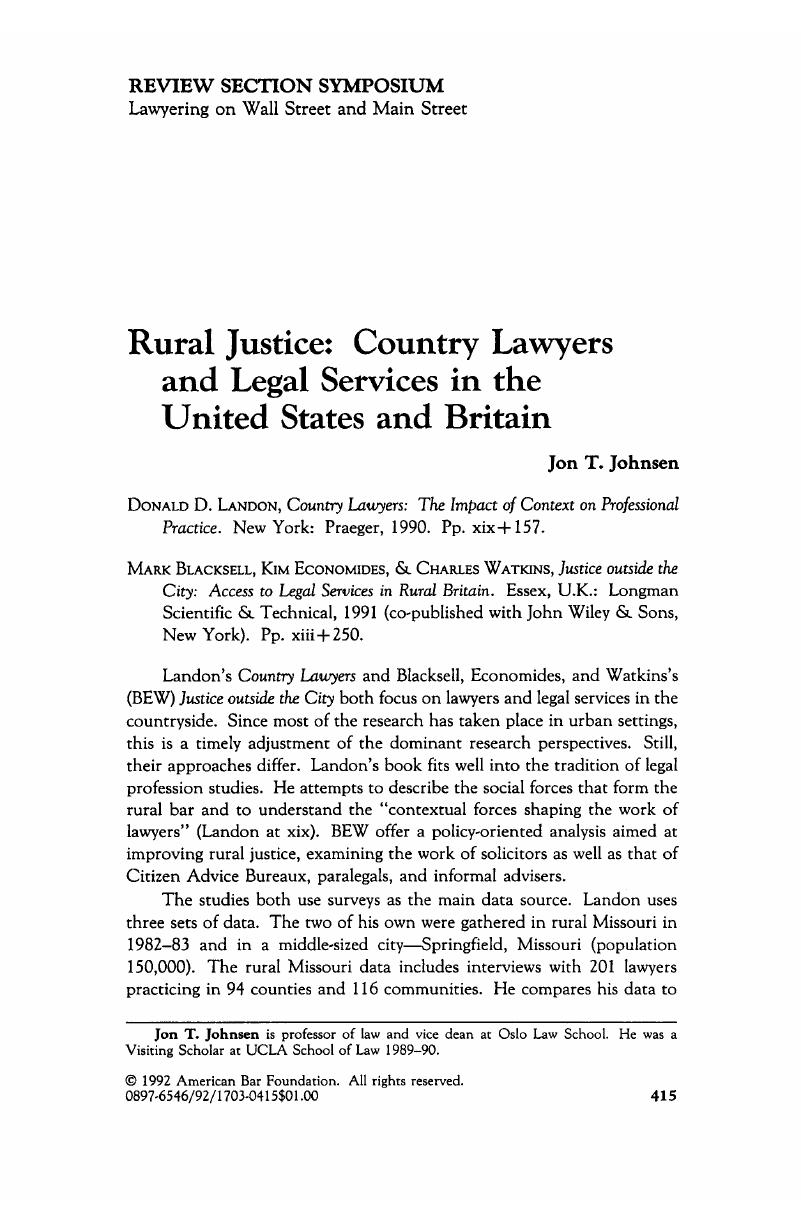Article contents
Rural Justice: Country Lawyers and Legal Services in the United States and Britain
Published online by Cambridge University Press: 27 December 2018
Abstract

- Type
- Review Section Symposium
- Information
- Copyright
- Copyright © American Bar Foundation, 1992
References
1 John P. Heinz & Edward O. Laumann, Chicago Lawyers: The Social Structure of the Bar (New York: Russell Sage Foundation; Chicago: American Bar Foundation, 1982).Google Scholar
2 Unpublished statistics from the Norwegian Advocates' Association.Google Scholar
3 Jon T. Johnsen, Retten til juridisk bistand 424 (Oslo: Tano, 1987) (“Johnsen, Rettentil”). See also Jon T. Johnsen, “The Professionalization of Legal Counseling in Norway,” in Richard L. Abel &. Philip S. C. Lewis, eds., Lawyers in Society: vol. 2, The Civil Law World 79 (Berkeley: University of California Press, 1988) (“Johnsen, ‘Professionalization’”).Google Scholar
4 Foster, K., “The Location of Solicitors,” 36 Mod. L Rev 153 (1973).CrossRefGoogle Scholar
5 Johnsen, Retten til 419–32; id., “Professionalization” at 85, 95.Google Scholar
6 Landon cites Jerome E. Carlin, Lawyers on Their Own: A Study of Individual Practitioners in Chicago 168 (New Brunswick, N.J.: Rutgers University Press, 1962) (“Carlin, Lawyers on Their Own”).Google Scholar
7 Landon cites Stephen Daniels, “Civil Litigation in Illinois Trial Courts: An Explanation of Rural-Urban Differences,” 4 Law & Pol'y Q. 190 (1982), and Engel, David M., “The Oven Bird's Song: Insiders, Outsiders, and Personal Injuries in an American Community,” 18 Law & Soc'y Rev. 551 (1984).Google Scholar
8 Landon cites Engel, 18 Law B Soc'y Rev., and Stewart Macaulay, “Non-contractual Relations in Business: A Preliminary Study,” 28 Am. Soc. Rev 55 (1963).CrossRefGoogle Scholar
9 Landon cites Zemans, Frances K., “Framework for Analysis of Legal Mobilization: A Decision-making Model,” 1982 ABF Res. J. 989.Google Scholar
10 BEW cite J. Jenkins, E. Skordaki, & C. Willis, “Public Use and Perception of Solicitors' Service,”in Research Study No. 1 (London: Research &a Policy Planning Unit, Law Society, 1989).Google Scholar
11 Johnsen, “Professionalization” at 55–59 (cited in note 3).Google Scholar
12 Johnsen, Retten til at 435 (cited in note 3).Google Scholar
13 Landon cites Carlin, Lawyers on Their Own (cited in note 6).Google Scholar
14 BEW cite P. C. S. Lewis, “Unmet Legal Needs,” in P. Morris, P. C. S. Lewis, & R. White, eds., Social Needs and Legal Action (London: Martin Robertson, 1973), and A. Paterson & D. Nelkin, “Evolution in Legal Services: Practice without Theory,” 3 Civ. Just. Q. (1984).Google Scholar
15 BEW cite B. E. Gates & E. M. Rawstron, Regional Variations in Britain: Studies in Economic and Social Geography (London: Batsford, 1971), and L. Mayhewh A. Reiss, “The Social Organization of Legal Contacts,” 34 Am Soc Rev. 309 (1969).Google Scholar
16 Stàle Eskeland & Just Finne, Rettshjelp (Oslo: Pax, 1973) (“Eskeland & Finne, Rettshjelp”); Jon T. Johnsen, “Udekkede rettshjelpbehov i to nordnorske lokalsamfunn,”Rettshejop i utkantstrk, pt. II (Oslo: Institute for Sociology of Law, University of Oslo, 1978) (“Johnsen, ‘Udekkede rettshjelpbehov’”); Børre Lid, “Fangers rettshjelpbehov,”Juss-Buss Report No. 15 (Oslo: Institute for Sociology of Law, University of Oslo, 1980); Merethe Haugen & Elisabeth Vigerust, “Rettshjelpbehovet” (forthcoming as a Juss-Buss Report, Fall 1992) (“Haugen &a Vigerust, ‘Rettshjelpbehovet’”). See as a Danish example, Lis Sejr, ed., Retsj ælp i et lokalormaide (Århus: University of Arhus, 1977). Johnsen, Retten til 255–74, presents a general approach to and analysis of methodology questions in action research. Information in this paragraph and the next two paragraphs relies on these sources.Google Scholar
17 See Johnsen, Retten til 382–89 for a more comprehensive discussion.Google Scholar
18 Id at 403–6, 415.Google Scholar
19 Id at 290–92, 502–3, and more detailed in Jon T. Johnsen, “Udekkede rettshjelpbehov” at 45–52 (cited in note 16).Google Scholar
20 Johnsen, Renen til 334–37, 339–40.Google Scholar
21 Id at 330, 335.Google Scholar
22 See Johnsen, “Professionalization” at 81, 117–18 (cited in note 3).Google Scholar
23 “Juss-Buss” (“law bus” literally translated) is the name of a student-run legal clinic at Oslo Law School. Mobile legal service delivery projects have constituted an important part of the activity since its beginning in 1971.Google Scholar
24 BEW seem to perceive this part of the Troms Study as a way of measuring latent demand and conclude that it indicated “a disproportionately large, latent demand for legal advice in rural areas” (BEW at 185). They apparently missed the point. Legal needs studies carried out in urban settings do not substantiate their conclusion. Unmet legal needs seem in Norway to occur roughly with similar frequency in the city and the countryside, although the structure differs in many respects. Compare Eskeland & Finne, Rettshjelp, and Haugen & Vigerust, Rettshjelpbehovet (both cited in note 16), with Johnsen, Retten til (cited in note 3). The study tried to map the importance of rural-urban factors to delivery models by applying the Juss-Buss model in both settings.Google Scholar
25 See Johnsen, “Professionalization” at 115.Google Scholar
26 Id. at 80.Google Scholar
27 Pollit, Daniel, “Timid Lawyers and Neglected Clients,” 81 Harper's Mag., Aug. 1964, at 81.Google Scholar
28 This has not always been the case. In his broad analysis of legal development in Norway, Aubert points to the sharp legal division, developed by the autocratic kings, that still persisted in the 19th century:.Google Scholar
There was separate legislation for cities and countryside about elections and local government, about schools, taxation, social assistance (the “poor” laws), fire insurance, communication, craft industries, trade, property in land and real estate. Hodne, who mentions these differences in his Economic History of Norway 1815–1970, points out that legal scholars have never seen any reason to even mention this legal dualism which in some areas has persisted up to the present time [Fritz Hodne, Norgges konomiske historie 30–34 (Oslo: Cappelen 1981)].Google Scholar
Vilhelm Aubert, Continuity and Development 167 (Oslo: Oslo University Press and Oxford University Press, 1989).Google Scholar
29 Langdell, Christopher Columbus, A Selection of Cases on the Law of Contracts vii (2d ed. Boston, 1871).Google Scholar
- 1
- Cited by


